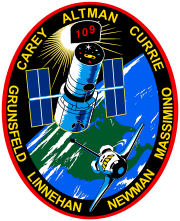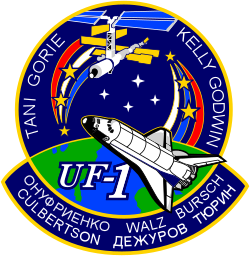STS-109
| STS-109 | |||||
 | |||||
| Uppdrag | 108 | ||||
|---|---|---|---|---|---|
| Rymdfärja | Columbia (27)[1] | ||||
| NSSDC-ID | 2002-010A[2] | ||||
| Färdens tid | 10 dagar, 22 timmar, 11 minuter, 9 sekunder | ||||
| Uppskjutning | |||||
| Startplats | Startplatta 39A vid Kennedy Space Center i Florida | ||||
| Start | 1 mars 2002 11:22:02 UTC | ||||
| Landning | |||||
| Landningsplats | KSC Runway 33 | ||||
| Landning | 12 mars 2002 9:33:10 UTC | ||||
| Omloppsbana | |||||
| Varv | 165 st[3] | ||||
| Banlutning | 28,5° | ||||
| Sträcka | 6,3 miljoner km | ||||
| Rymdpromenad | |||||
| Antal | 5 st | ||||
| Total tid | 35 timmar, 55 minuter | ||||
| Besättning | |||||
| Befälhavare | Scott Altman (3) | ||||
| Pilot | Duane G. Carey (1) | ||||
| Uppdragsspecialister | Nancy J. Currie (4) James H. Newman (4) Richard M. Linnehan (3) Michael J. Massimino (1) | ||||
| Nyttolastspecialister | John M. Grunsfeld (4) | ||||
 | |||||
| Kronologi Rymdfärjeprogrammet | |||||
| |||||
STS-109 var en rymdfärjeflygning i det amerikanska rymdfärjeprogrammet. Det var den tjugosjunde flygningen med Columbia. Den sköts upp från Pad 39B vid Kennedy Space Center i Florida den 1 mars 2002. Efter nästan elva dagar i omloppsbana runt jorden återinträdde rymdfärjan i jordens atmosfär och landade vid Kennedy Space Center.
Uppdraget var att serva Rymdteleskopet Hubble.
Se även
Referenser
- ^ NASA Space Shuttle Launch Archive Arkiverad 18 mars 2017 hämtat från the Wayback Machine., läst 28 juli 2016.
- ^ ”NASA Space Science Data Coordinated Archive” (på engelska). NASA. https://nssdc.gsfc.nasa.gov/nmc/spacecraft/display.action?id=2002-010A. Läst 22 mars 2020.
- ^ Manned Astronautics - Figures & Facts Arkiverad 16 augusti 2016 hämtat från the Wayback Machine., läst 28 juli 2016.
Externa länkar
 Wikimedia Commons har media som rör STS-109.
Wikimedia Commons har media som rör STS-109.
| ||||||||||||||||||||||||||||||
| ||||||||
| ||||||||||||||||||||||||||||||||
Media som används på denna webbplats
Författare/Upphovsman: Pascal (Flickr user: pasukaru76), Licens: CC0
Vostok spacecraft replica at the Technik Museum Speyer, Germany.
This is the mission patch of STS-108. Space Shuttle Endeavour is seen approaching the International Space Station. Two astronaut symbols represent the crew commanders of both ISS expeditions. The ascending one represents cosmonaut Yury Onufriyenko of Russia. (The ascending astronaut symbol shows a flag of Russia.) The descending astronaut symbol represents Frank Culbertson of the USA. This represents crew rotation, as three stars are depicted on the symbols. The space shuttle crew members are depicted along the border while the ISS crews are depicted along the chevron on the border of the patch.
- This is the insignia for the STS-108 mission, which marks a major milestone in the assembly of the International Space Station (ISS) as the first designated Utilization Flight, UF-1. The crew of Endeavour will bring the Expedition Four crew to ISS and return the Expedition Three crew to Earth. Endeavour will also launch with a Multi-Purpose Logistics Module (MPLM) that will be berthed to ISS and unloaded. The MPLM will be returned to Endeavour for the trip home and used again on a later flight. The crew patch depicts Endeavour and the ISS in the configuration at the time of arrival and docking. The Station is shown viewed along the direction of flight as will be seen by the Shuttle crew during their final approach and docking along the X-axis. The three ribbons and stars on the left side of the patch signify the returning Expedition Three crew. The red, white and blue order of the ribbons represents the American commander for that mission. The three ribbons and stars on the right depict the arriving Expedition Four crew. The white, blue, red order of the Expedition Four ribbon matches the color of the Russian flag and signifies that the commander of Expedition Four is a Russian cosmonaut. Each white star in the center of the patch represents the four Endeavour crew members. The names of the four astronauts who will crew Endeavour are shown along the top border of the patch. The three astronauts and three cosmonauts of the two expedition crews are shown on the chevron at the bottom of the patch.
Emblem of Nasa's STS-109 mission.
STS110-S-001 (August 2001) --- The STS-110 mission begins the third and final phase of construction for the International Space Station (ISS) by delivering and installing the SØ truss segment that will be carried into orbit in the payload bay of the Space Shuttle Atlantis. The Station’s robotic arm will remove the SØ segment from the Shuttle’s payload bay and place it on top of the United States Laboratory. During several space walks, SØ will be mechanically attached to ISS, and then multiple cables will be connected allowing electrical power and communications to flow between SØ and ISS. The STS-110 crew patch is patterned after the cross section of the SØ truss, and encases the launch of the Shuttle Atlantis and a silhouette of the ISS as it will look following mission completion. The successfully installed SØ segment is highlighted in gold. The SØ truss will serve as the cornerstone for the remaining ISS truss segments which together will span a distance greater than the length of a football field. This truss holds the Station’s massive solar arrays, providing electrical power for the modules of all the International Partners, and enables ISS to reach its full potential as a world-class research facility. The NASA insignia design for Shuttle flights is reserved for use by the astronauts and for other official use as the NASA Administrator may authorize. Public availability has been approved only in the forms of illustrations by the various news media. When and if there is any change in this policy, which is not anticipated, the change will be publicly announced.
The crew of Space Shuttle mission STS-109. NASA photo STS109-S-002 taken November 2001. From the left are astronauts Michael J. Massimino, Richard M. Linnehan, Duane G. Carey, Scott D. Altman, Nancy J. Currie, John M. Grunsfeld and James H. Newman. Altman and Carey are commander and pilot, respectively, with the others serving as mission specialists. Grunsfeld is payload commander.
The Hubble Space Telescope as seen from the departing Space Shuttle Atlantis, flying STS-125, HST Servicing Mission 4.









